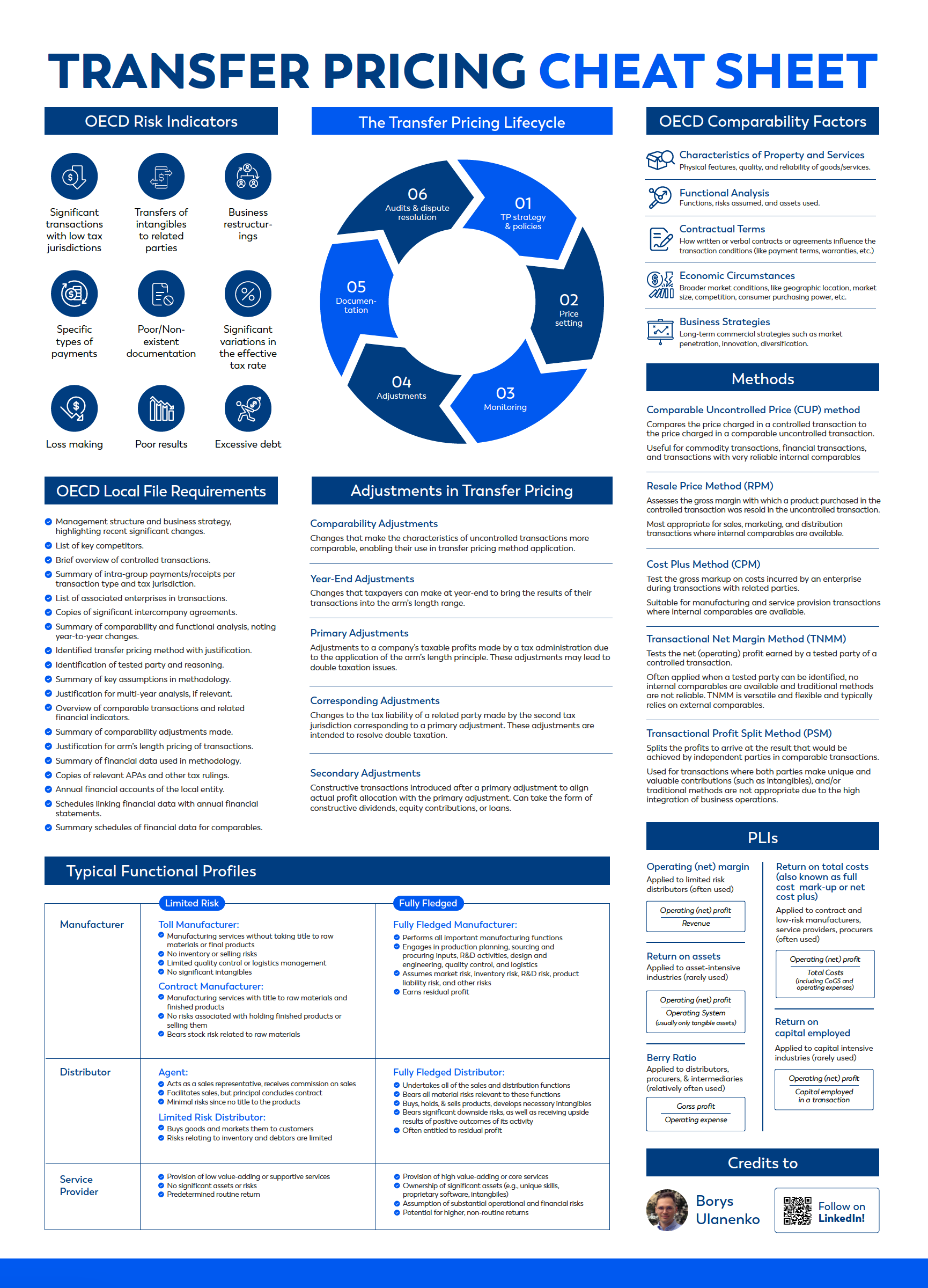3 Things Every Tax Professional Should Remember When Preparing TP Forms (what are TP forms, actually?)
Borys Ulanenko
What are TP forms?
In 2015, the OECD finalised the BEPS Action 13 Final report, which proposed the implementation of universal transfer pricing documentation standards.
Based on
the countries’ best practices and a growing level of tax cooperation between
governments, the OECD has developed a three-tiered approach to transfer pricing
documentation. The three-tiered structure consists of (1) a local file that
refers specifically to the material transactions of the local taxpayer; (2) a
master file containing standardised information relevant for all MNE group
members; and (3) a Country-by-Country Report (CbCR) containing certain
information relating to the global allocation of MNE income and taxes, together
with certain indicators of the location of economic activity within MNE groups.
Additionally, in the context of risk assessment,
the OECD Guidelines (para. 5.15) recognise that “there is a variety of tools and sources
of information used for identifying and evaluating transfer pricing risks of
taxpayers and transactions, including transfer pricing forms (to be filed with
the annual tax return)”, and “transfer pricing mandatory questionnaires
focusing on particular areas of risk.” Therefore, OECD recognises the right of
tax administrations to introduce additional requirements (not covered by the
three-tiered approach) and acknowledges the usefulness of the information gathered
for the transfer pricing risk assessment.
Generally, requiring taxpayers to
disclose specific information related to ownership and associated party
transactions serves two main goals:
- The information allows the tax administration to identify and assess transfer pricing risks.
- The requirement itself generates awareness and promotes compliance with the transfer pricing rules.
As a result,
in addition to a local file requirement, many countries require taxpayers to
submit transfer pricing forms (also sometimes called “transfer pricing returns”,
“transfer pricing disclosures”, etc.). This is a reporting form that is often
submitted annually together with a tax return, and in the majority of cases,
consists of a table with a list of controlled transactions conducted by a
taxpayer throughout the year (sometimes also indicating transfer pricing methods
used by the taxpayer in these transactions).
In contrast to the local file standard (that is
broadly consistent among countries), transfer pricing form requirements vary significantly
in scope and complexity. The illustration
below provides several examples of local transfer pricing forms:

In some countries, transfer pricing forms are hybrids between informational returns and local files. For example, Belgium 275 LF form effectively replaces local file requirement. In some countries, though, very detailed transfer pricing forms work exist in parallel with the local file (i.e., Poland).
Three crucial things to remember when preparing and filing the forms:
- Remember that the transfer pricing
forms are mainly risk assessment tools. This means that tax authorities will try to
identify risky arrangements to allocate their audit resources effectively. For
example, significant transactions with low-tax jurisdictions, material royalty
payments, excessive management fees, application of transfer pricing methods that
are generally not appropriate to particular transactions can draw the attention
of tax authorities and “invite” the audit.
- Consistency is crucial. Frequent changes in the methods, material one-off transactions, significant swings in materiality can result in additional questions. Where there are sound business reasons for such events, taxpayers should carefully document them and be ready to explain circumstances to the officer.
- Accuracy. Often, taxpayers do not take the forms seriously, as penalties are often immaterial. However, a significant deviation of the TP form data from reality can erode the trust of tax administration and therefore increase the risk profile of the taxpayer. Remember - tax authorities have access to other information (like export/import declarations, CbCR, tax returns, financial statements) and often can cross-check the data. Put yourself in the tax officers’ shoes and imagine a situation where taxpayer “forgot” to disclose material cross-border transactions (especially that carry significant tax abuse potential). What would be your reaction?
We discuss transfer pricing forms in greater detail in our transfer pricing textbook (Chapter 16). Also, sign up for our transfer pricing course and go to Module 16 for the discussion about transfer pricing compliance, forms and risk assessment.
Contact us: study@startaxed.com

We are an online educational platform that helps professionals and aspiring individuals to succeed in their goals.
Featured links
Get your free TP cheat sheet!
Discover the essential concepts of TP in one concise, easy-to-follow cheat sheet.

Thank you! Download here.
What is the EU Directive?
The EU is run by an elected EU Parliament and an appointed European Council. The European Parliament approves EU law, which is implemented through EU Directives drafted by the Commission. National governments are then responsible for implementing the Directive into their national laws. In other words, EU Directives are draft laws that then get passed by national governments and then implemented by institutions within the member states.
What is CbCR?
Country-by-Country Reporting (CbCR) is part of mandatory tax reporting for large multinationals. MNEs with combined revenue of 750 million euros (or more) have to provide an annual return called the CbC report, which breaks down key elements of the financial statements by jurisdiction. A CbC report provides local tax authorities visibility to revenue, income, tax paid and accrued, employment, capital, retained earnings, tangible assets and activities. CbCR was implemented in 2016 globally.
